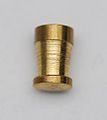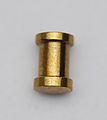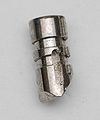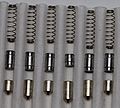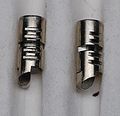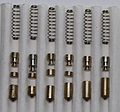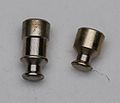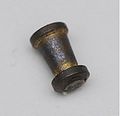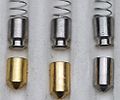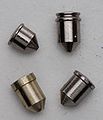Security pin
Security Pin
A security pin is a modified version of a key or driver pin in a pin-tumbler lock that makes manipulation more difficult. Security pins are commonly designed to prevent lockpicking, but are also designed to resist decoding, impressioning, key bumping, and other compromise techniques. Similar modifications to components in non-pin locks are also common, with serrated components being the most popular in both wafer and lever locks. Combination and disc-detainer locks commonly use false gates to prevent manipulation.
Principles of operation
Security pins are designed so that use of a tool other than a key will trigger the pins and lock one or more pins at the shear line. This can be due to individual manipulation of components or tension on the cylinder. When triggered, security pins bind between the plug and cylinder, blocking the rotation of the plug until tension on the cylinder is released and pins are dropped back to their resting position.
Types of security pins
- Mushroom
- A top or bottom pin with a beveled cut around their circumfrence, resembling a mushroom shape. Top pin mushroom designs are much more common, but companies like Mul-T-Lock use them for bottom pins, as well.
- Spool
- A top pin with a portion of the center removed, resembling a spool or barbell shape. Triggers when the center of the spool is caught at the shear line.
- Serrated
- A top or bottom pin with light serrations around the circumfrence of the pin. Triggers when a serration is caught at the shear line.
- Hybrid
- A combination of the previous three designs. For example, "spoorated" is a spool pin with serrations on the outer edges of the pin.
Gallery
Medeco Biaxial; mushroom top pins (gold).
A Medeco Biaxial; pin with false sidebar groove and anti-decoding ring.
Medeco Biaxial; pin with anti-decoding ring and micro-milled sidebar slot.
KABA Gemini; serrated bottom pin.
ASSA Twin V-10; double spool top pins.
ASSA Twin V-10; serrated side pins.
ASSA Twin Combi; graduated and double spool top pins.
Miracle Magnetic spool pin.
MIWA 3800 security pins.
Hi-Shear LK1200 security pins.
Scorpion CX-5 security pins.
LIPS Octro security pins (key pins).
LIPS Octro security pins (driver pins).
